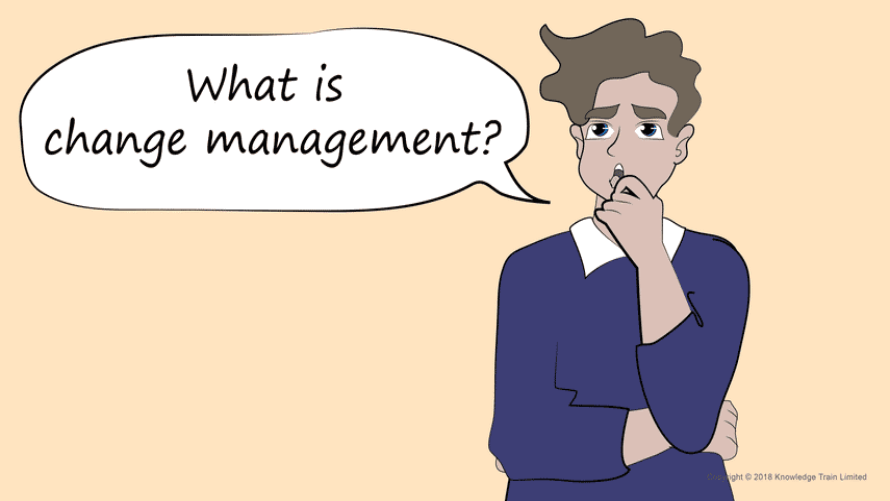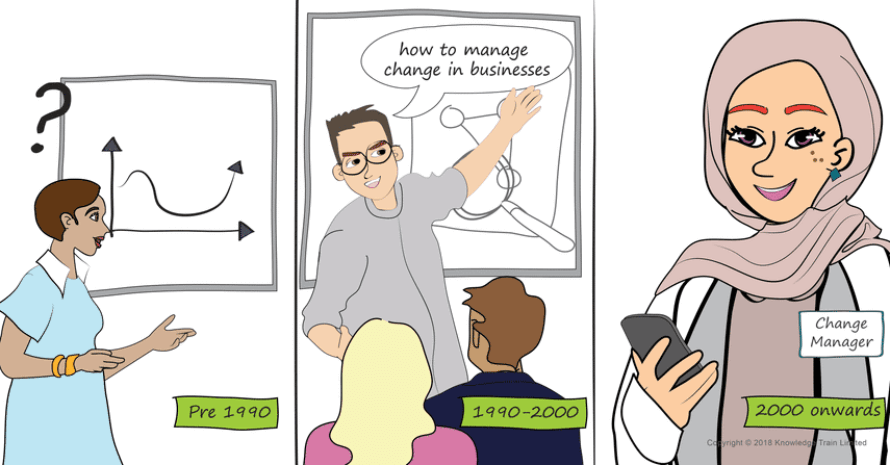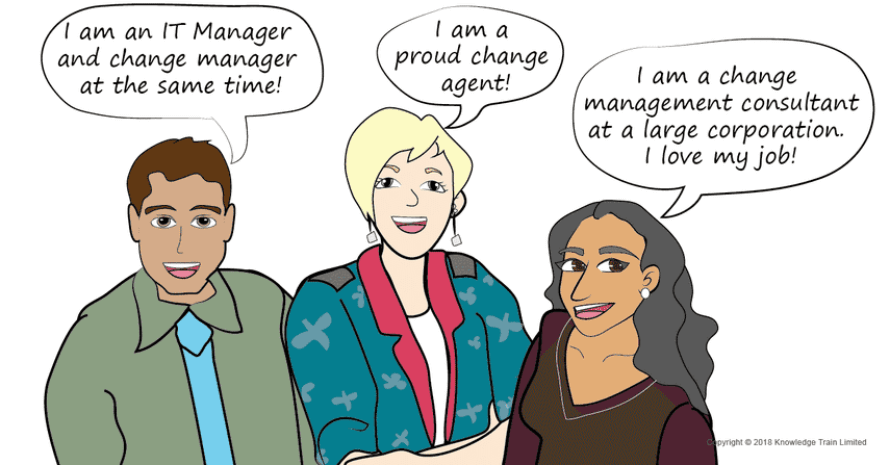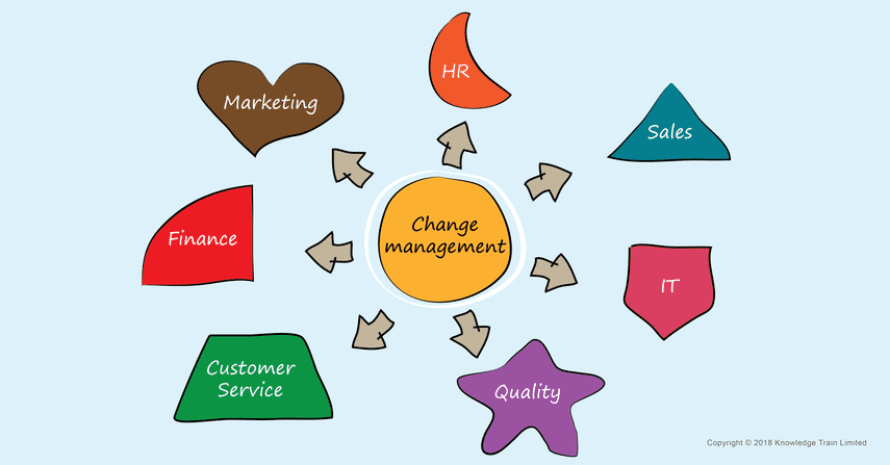Click for change management certification and training options
About change management

Change isn’t easy. It requires total belief in the cause, dedication and hard work. The most common change everyone in the world is doing right now is weight loss. You can say “I want to become healthier and lose weight”, but saying your intention isn’t enough. You need to be motivated and convinced to do it. Then, you can ask for professional help to assist you with a scientific plan that suits your current health status to guarantee desired results.
Now this is changing something for the better on an individual level. But what about changing something for the better on an organisational level? Organisations consist of not only one individual, but LOTS of different and diverse individuals in addition to IT systems, common ways of working and the need to make profit! Imagine the size of work that needs to be done!
That’s one of the reasons why professionals wanting to get into a change management career choose to get a professional change manager certification by attending change management courses.

Change management definition
Change management is simply defined as a structured approach to moving an organisation from the current state to the desired future state [1].
Change in an organisation can be any minor or major alteration in internal structure, policies, strategic plans, organisational culture, IT solutions or marketing/sales approaches. Such change is normally implemented to achieve an improvement. Organisational change often causes resistance, which is a natural reaction and must be taken into consideration.
Applying change in organisations is a hefty task. It is extremely challenging but rewarding at the same time. It is now a field of management on its own and is studied as an academic and professional course in universities, colleges and institutions.

Evolution of change management
Before 1990, understanding change and its effects on human beings was an ongoing study among thinkers, academics and psychologists.
However, change became a hot topic in the early 1990s, being spoken about as a discipline in project meetings and at boardroom tables. It became mainstream after a couple of companies and authors put change on the map through new processes and school of thought. Some examples are:
- General Electric introduced the Change Acceleration Process as part of its larger improvement program.
- Todd Jick, a senior lecturer in Columbia Business School, introduced the Ten Commandments of Implementing Changein his famous textbook “Managing Change: Cases and Concepts”.
- Spencer Johnson, author of “Who Moved my Cheese?”, amuses us with his mouse maze allegory about change and how to deal with it[2].
In the year 2000 and onwards, the change discipline became formalised as another type of management, and official frameworks started to develop. In 2005, the Change Management Institution (CMI) was established in Sydney, Australia. They have authored “The Effective Change Manager: The Change Management Body of Knowledge” (CMBoK) and it is widely recognised as one of the best books in change management.

Organisational change management
Without a doubt, globalisation and the rapid adoption of digital solutions are the reasons why change is constantly initiated in the modern business world. To succeed in this competitive environment, business leaders and project managers must keep an open mind, being able to deal with rapidly changing requirements and shape them into tangible outcomes. Organisational change management (OCM) helps by equipping managers with the skills and tools required to effectively manage such change.
Organisational change managers now have a variety of formal frameworks and accredited certifications to choose from, thanks to institutions like CMI. Organisational leaders and decision-makers can now propose change with confidence and work with their teams towards better results.

Organisational change management best practices
Organisational change management is concerned with implementing change management at an organisational level. Whenever change occurs within an organisation it impacts the individuals within it.
Organisational change management is a body of professional best practice which focuses on change projects. These projects can include changing roles, structures, culture and the business as a whole. Within organisational change management, teams are coached to align the transitions of their projects to the organisation.
Professional change managers often equip themselves with an understanding of these change management best practices by gaining professional change management certification, often by attending one of these change management courses.
Understanding organisational change
Organisational change comes in many shapes and forms. It might be a new software system or a new way of doing business in response to legal changes. When you introduce any change to an organisation, you will ultimately impact one or more of the following:
- Processes
- Systems
- Organisation hierarchy
- Job roles
Change managers and certification
To successfully manage a change programme, organisations employ educated, certified change managers to offer support via their leadership and development plans.
A programme in change management help those involved manage their teams over the process of organisational change to ensure a successful outcome.
Project management
Project management is a related discipline that addresses the management of activities required for a business to deliver products, create valuable outputs, and realize benefits.
Getting staff to use these outputs and products (these may be new systems or new processes) and influencing long-term behaviours within an organisation is the job of change managers.
Organisational change process
Effective change management requires change managers to implement effective planning and scheduling and address more human issues.
An effective organisational change process involves applying best practice approaches and strategies. By doing so, you can become an effective agent of change within your organisation. Some of these best practice approaches are described below.
1. Readiness assessments
Change management teams use a wide array of assessments to determine an organisation’s willingness to change.
These might include organisational assessments, culture assessments, employee assessments, or change assessments.
Each provides insight into the challenges and opportunities change managers may face during the change process.
2. Communication and communication planning
The first step in managing change is building awareness and creating a desire for change among employees.
Initial communications are designed to build awareness about the reasons for change and the risk of not changing.
Communication planning begins with a careful analysis of audiences and key information. The change management team must design a communication plan that addresses the needs of frontline employees, supervisors, and executives.
Each audience will need specific information based on their role in the process of change. Change managers will also need to think about the best way of communicating this information.
3. Training in change management
Training is key to building the required skills needed to succeed in the future state of business processes. Ensuring that those most affected by change receive the training they need at the right time is a primary role of change management.
Change managers will need to develop training schemes based on the skills and knowledge needed to facilitate the change.
4. Resistance management
Resistance from employees and managers is normal and should be proactively addressed. Change managers need to identify, understand, and help manage resistance.
Resistance management is the process and tools used by change managers to accommodate change in those areas of business most resistant to change.
Resistance can come in many shapes and forms. Most commonly, it can be found in individuals accustomed to the current way of doing things.
Occasionally, change managers may encounter institutional resistance in the form of decision-making hierarchies and existing power structures. These can be a little trickier to navigate, but still possible should change managers follow the principles and procedures outlined in many common change management frameworks.
5. Feedback and corrective action
Employee involvement is an integral part of change management. Change managers must analyse feedback and implement actions based on this feedback to ensure the smooth integration of changes.
6. Post-project review
The final step in the change management process is to review the effects of change, both positive and negative.
Change managers must learn how to adapt their techniques for use in the next change project. This is part of the ongoing, continuous improvement of organisational change management.
Good change managers analyse each component of organisational change to ensure future project success, avoid the loss of productivity and minimize the negative impact of the change.
Organisational change principles
- Active leadership – Change managers must lead by example and exhibit the behaviours and attitudes they expect employees to adopt.
- Structured approaches – Change managers use structured organisational change management processes and models wherever possible.
- Detailed plans – Every change project begins with plans that detail the desired outcomes of organisational change and how best to achieve these.
- Assessment – Change managers must continuously assess how ongoing organisational changes affect the business and adjust their strategy from moment to moment.
- Team involvement – Change managers must strive to involve every layer of business from executives to middle managers and their teams to ensure organisational change initiatives have the required support.
- Open communication – Change managers must consult with staff and ensure each member knows their role in the organisational change initiative.
- Managing resistance – Change managers must identify and overcome common barriers to organisational change.
- Evaluation – Change managers must identify what works and what does not, then use this information to improve organisational change management practices for future projects.
By following these principles, change managers can quickly adjust their approach according to the fluctuating and uncertain nature of organisational change.
Change management strategies
Leadership engagement
You need to start from the top of the organisation and frequently engage with its leaders. You can follow these steps to engage with leaders:
- Make a list of responsibilities for each leader;
- Ask for an initial meeting;
- Prepare a vision statement and strategy for discussion;
- Create a leadership committee for the OCM project;
- Set up periodic meetings with the committee to report the progress;
Governance enforcement
Organisational change management needs effective governance. Governance rules ensure that the change initiative is backed up from the project sponsor. If effective governance doesn’t apply for OCM, other priorities will compete against the change plan. You don’t want the OCM team taking the back seat!
Project team coordination
The OCM team must coordinate with the project manager and the project team. Aligning activities and managing processes with theirs is important to gain the support you need.
Communication
Communicating plans early is one of the core strategies of OCM in companies. You need to ask yourself:
- Who needs to know?
- When do they need to know?
- What form, format, and quantity can they best receive the information?
Awareness and participation
One of the OCM team’s task is to spread awareness about the change. It helps to gain a sense of ownership from employees and leaders and hence, more participation. Planning a workshop or training session will help spread the message.
An understanding of change impacts
Change will face resistance. So, it’s crucial to understand the nature of the forces you are suggesting. Because it allows you to make proper decisions to help people adapt to them. In addition, you can guide individuals about how to cope with the changes.
Knowledge transfer
For change to be successful, you need to create a knowledge transfer plan. Types of knowledge transfer plans can include:
- Interactive FAQs;
- Templates;
- Desktop procedures;
- Process maps;
- Coaching;
- Training classes.
Feedback encouragement
You need to actively seek out the resistance. Also, approach people to ask for feedback. In this way, you can work to understand the source of concern. Positive or negative feedback helps to enhance the OCM plan.
Reward system creation
Create an incentive structure for staff who choose to participate in the change initiative. People then contribute successfully at a much greater level. Recognising individuals across the organisation by itself is a reward.
Success measurement and failure evaluation
Install mechanisms and tools that can measure success and report on them at an agreed-upon frequency. You can deal with, learn from, and react to a failure that has been measured. Success stories become best practices for the enterprise.
Change management models
To help equip change managers with the toolsets to enable change within organisations, change management courses teach practitioners many different processes, tasks, and tools to enable effective and smooth transitions.
There are numerous change management frameworks, or models for organisational change management. The most well-known are:
Lewin’s three stage model
This process shows you how collective mindsets are broken down to enable change by three stages:
- Unfreeze Stage: Where you define the current situation, create a vision of the desired end-state, and then identify the forces that will help drive and resist change.
- Change Stage: Where a plan is followed to implement change, involve people, allow experimentation over solutions to problems and then provide great role models with whom people in change can identify.
- Refreeze Stage: Where new work practices become new work habits, new ways of thinking and reward behaviours and results that are aligned with the changed environment. [3]
Kotter’s eight step model
This process shows a road map for change based on common errors made by organisations. Kotter’s underlying assumption is that given the right process and the right leadership, change can be planned and managed. The eight steps are:
- Establishing a sense of urgency
- Creating the guiding coalition
- Developing a vision and a strategy
- Communicating the change vision
- Empowering employees for broad-based action
- Generating short-term wins
- Consolidating gains and producing more change
- Anchoring new approaches in the culture. [4]
Senge’s systems thinking model
This model shows how profound change can be achieved through learning. [5] The five learning disciplines it suggests are:
- Shared Vision:To use tools such as ‘Positive Visioning’, ‘Concept-shifting’ and ‘Values Alignment’ to create a shared vision.
- Mental Models:To use tools like the ‘Ladder of Inference’ and ‘Reflective Inquiry’ to make their mental models clearer.
- Personal Mastery:To use tools like ‘Perceptual Positions’ and ‘Reframing’ to enhance the quality of interaction and relationship in and outside their teams.
- Team Learning:To use tools like the ‘Action-Learning Cycle’ and ‘Dialogue’ to develop critical reflection skills.
- Systems Thinking:to use tools like ‘Systems Thinking Maps’ and ‘Archetypes’ to map and analyse situations, events, problems and possible causes/courses of action to find better change options/solutions. [6]

Who performs change management?
In general, any employee in an organisation can be appointed as a change agent, in addition to their current job role, to be a positive and influential force for the change activities upper management has planned for and to deliver the change message to everyone.
But it is up to the change managers/change team members, who could be executives, managers, team leaders, project teams and their support in any department to:
- Create and develop the change management strategy and plans
- Financially fund the strategy
- Train staff, spread awareness and boost activities
- Manage the technical resources
- Standardise the proven successful methodology and apply it in the organisation.

Change across business areas
Change management is intertwined with almost all management areas and departments in an organisation. Each member of these departments is considered a stakeholder. Some of them are:
- Project & programme management:new projects or programmes are normally initiated to enhance and change something in the organisation. Change management is therefore very closely related to this department, working in parallel to the project, or after it has finished. Change managers are often an important part of the project team.
- Finance management:transformations in the finance department, like reducing close-cycle time or financial process improvement, would need the help of change management.
- Human resources management:people-oriented professionals who develop the human capital of their organisation, such as HR, should be the first to step into change agent roles.
- Information Technology (IT) departments:new systems, networks, software and hardware integration rely heavily on change management. That is why change management is one of the processes in the service transition stage of ITIL.
- Quality management:any change implemented in the organisation will affect the quality management department and they’ll have to update their systems (QMS) accordingly.
- Customer service department:change applied to the organisation’s internal customers and processes will eventually affect external customers. Change managers therefore need to work closely with customer services.
- Sales & marketing departments:change management is always about making something better, so there will consequently be better products/services and selling margins.

Emerging profession
Change manager roles did not exist 30 years ago. Now it is a must-have position in most large corporates and companies due to the continuous demands of our contemporary world. There are dedicated teams and even departments for change management. If not, outsourced consultancies with trained professionals are hired to make changes happen.
Change management is not only a discipline, but also a competency every leader, line manager and decision maker must learn to understand, design and implement for their 21st century business.
Are you now inspired to gain change management certification? Knowledge Train runs change management courses accredited by APMG International in partnership with the Change Management Institute (CMI). These courses equip students with the knowledge of modern best practices in change management. They are an important part of any change manager’s toolbox.
You can enrol for the 3-day Change Management Foundation course, or the 5-day Change Management Foundation & Practitioner course.
References
[1] APM. (Unknown). Change management. Available: https://www.apm.org.uk/body-of-knowledge/delivery/scope-management/change-management/. Last accessed 07 June 2024.
[2] Prosci. (Unknown). THE HISTORY AND FUTURE OF CHANGE MANAGEMENT. Available: https://www.prosci.com/change-management/thought-leadership-library/history-and-future-of-change-management. Last accessed 07 June 2024.
[3] [4] [5] The Change Management Institute (CMI) (2014). The Effective Change Manager’s Handbook. Australia: Vivid Publishing. 36-42.
[6] Bill Cropper. (Unknown). Five Learning Disciplines. Available: http://www.thechangeforum.com/Learning_Disciplines.htm. Last accessed 07 June 2024.
Change Management related articles

Unveiling the impact of Senge’s system thinking model on change management

How ADKAR can revolutionise your change management strategy

What jobs are available in change management?

What is change management certification?

How APMG Change Management qualifications can help your career

What qualifications do change managers need?

Is Change Management the course for you?

Navigating the change curve for successful transitions

What is a business change manager?

Thriving in Change – Webinar with Luz Flores Lee

The importance of change management

How to become a change manager

Guiding your team through change using the Satir change model

Is change management a good career choice?

The essentials of Lewin’s change model for successful change management

Change management skills

Change management qualifications for professionals

Change management models



